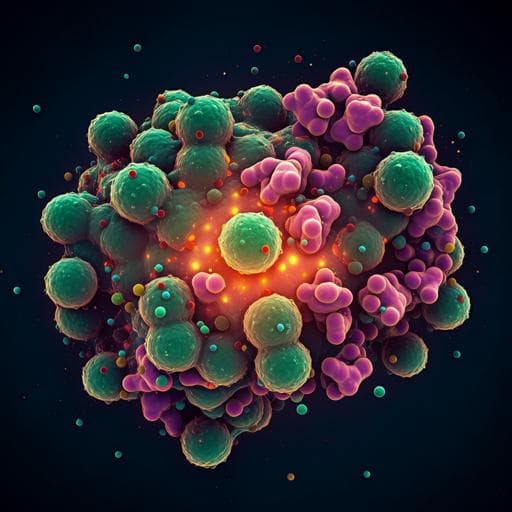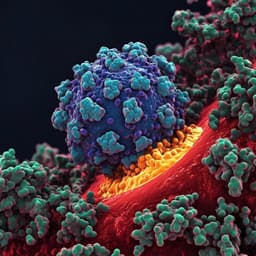
Medicine and Health
The complex structure of GRL0617 and SARS-CoV-2 PLpro reveals a hot spot for antiviral drug discovery
Z. Fu, B. Huang, et al.
This groundbreaking research by Ziyang Fu and colleagues reveals GRL0617 as a potent inhibitor of SARS-CoV-2 papain-like protease (PLpro), shedding light on its structural interactions and potential for antiviral drug development.
~3 min • Beginner • English
Introduction
The COVID-19 pandemic has caused widespread morbidity and mortality, with SARS-CoV-2 as the etiological agent. SARS-CoV-2 encodes two cysteine proteases, Mpro and PLpro, essential for viral polyprotein processing and for modulating host immune responses. Prior efforts have identified potent Mpro inhibitors, but effective PLpro-directed therapeutics remain limited. Given PLpro’s roles in deubiquitination and deISGylation that suppress innate immunity, the study aimed to evaluate PLpro as a drug target by repurposing approved drugs and characterizing known PLpro inhibitors. The central research questions were whether small molecules can potently inhibit SARS-CoV-2 PLpro enzymatic and antiviral activities and what structural features underlie inhibition, with the broader goal of identifying a druggable hot spot for antiviral development.
Literature Review
Previous studies established PLpro’s multifunctionality in processing viral polyproteins and antagonizing host immunity via deubiquitinating and deISGylating activities. Potent covalent inhibitors of the related viral protease Mpro have been structurally characterized, guiding structure-based drug design. For PLpro, naphthalene-based noncovalent inhibitors such as GRL0617 inhibited SARS-CoV PLpro, suggesting cross-reactivity potential given ~83% sequence identity with SARS-CoV-2 PLpro. Reports also indicated SARS-CoV-2 PLpro preferentially exhibits deISGylating activity over deubiquitinating activity and that inhibition of deISGylation correlates with antiviral activity. Structural work on SARS-CoV-2 PLpro bound to ISG15 or ubiquitin showed that the S1 site engages the ISG15 C-terminal lobe and tail. Notably, similar pockets in human DUBs (USP7, USP14) host noncovalent inhibitors that block Ub C-terminus binding, implying conserved druggable sites across USPs. MERS PLpro differs structurally at the BL2 loop, explaining poor potency of GRL0617 analogs against MERS PLpro.
Methodology
- High-throughput screening: A 2040-compound FDA/CFDA-approved library was screened against recombinant full-length SARS-CoV-2 PLpro using a FRET assay with RLRGG-AMC substrate (50 µM) in 384-well plates. Assay buffer: 50 mM HEPES pH 7.4, 0.01% Triton X-100, 0.1 mg/mL BSA, 2 mM DTT; PLpro at 100 nM. First-round hits required ≥50% inhibition at 100 µM; ~30 compounds advanced. 6-thioguanine (6-TG) served as positive control (IC50 72 ± 12 µM). After excluding problematic compounds, seven drugs were profiled (IC50 29–91 µM).
- Candidate inhibitors: GRL0617 and analog compound 6 (from SARS-CoV literature) were tested; IC50 values determined using the same FRET assay.
- Cellular assays: HEK293T cells were transfected with GFP-PLpro, ISG15, and ISGylation machinery (Ube1L, UbcH8, HERC5) to monitor deISGylation and deubiquitination via immunoblotting (anti-ISG15, anti-ubiquitin, anti-GFP). GRL0617 was added at varying concentrations for 24 h. IFN-β (500 U/mL, 48 h) was used to induce ISGylation in HEK293T; lysates were incubated with recombinant PLpro (100 nM) ± GRL0617 (dose range) to assess target engagement and selectivity. Recombinant mouse USP18 activity with ISG15-AMC was tested ± GRL0617 to assess off-target effects.
- Antiviral assays: Vero E6 cells were infected with SARS-CoV-2 (MOI 0.01). GRL0617 dose-response (1.56–100 µM) was tested. Viral RNA (spike gene) in supernatants at 48 h was quantified by qRT-PCR using a standard curve. Cytotoxicity was measured by CCK8 after 48 h. Cytopathic effect (CPE) assays determined EC50.
- Protein production: SARS-CoV-2/SARS/MERS PLpro constructs (Nsp3 protease domains) were expressed in E. coli BL21 (DE3) with N-terminal His-tags; mutants C111S, D164A, E167A generated by site-directed mutagenesis. Human ISG15 (1–157) and truncations (ΔC6, ΔC5, ΔC4) and human Ub were expressed in E. coli; 15N-labeled ISG15/Ub prepared in M9 medium. mUSP18 (46–368) was expressed in Sf9 via MultiBac. Proteins purified by Ni-NTA and size exclusion chromatography.
- Crystallography: Co-crystals of SARS-CoV-2 PLpro C111S with GRL0617 were grown by sitting-drop vapor diffusion after 20 h preincubation (9.5 mg/mL PLpro, 2 mM GRL0617) at 4 °C. Well: mixed metal chlorides, 0.1 M HEPES pH 7.5, 12% PEG 3350; crystals soaked in cryo with 400 µM GRL0617 and 20% glycerol, flash-frozen. Data collected in-house; structure solved by molecular replacement (apo PLpro C111S template PDB 6WRH), refined with PHENIX and Coot. Space group I4122; resolution 3.2 Å. Coordinates deposited (PDB 7CJM).
- NMR: 1H,15N-HSQC spectra recorded at 600 MHz, 25 °C with 0.1 mM 15N-ISG15 ± 0.15 mM PLpro and GRL0617 titration (0.05, 0.15, 0.25 mM) in 30 mM Tris, 100 mM NaCl, pH 7.4, 5% DMSO, 10% D2O. 15N-Ub titrated with PLpro up to molar ratio 3. Peak broadening/intensity changes assessed for binding and competition.
- ITC: MicroCal ITC200 at 25 °C in PBS. SARS-CoV-2 PLpro (92–100 µM) in cell; ISG15-FL or truncations (ΔC6, ΔC5, ΔC4) at 0.95–2 mM in syringe. Similar experiments with SARS and MERS PLpro for ΔC6. Binding parameters (Kd, ΔH, N) determined.
- Enzymatic assays with mutants: Activities of WT, D164A, E167A PLpro (100 nM) assessed on peptide RLRGG-AMC (100 µM), ISG15-AMC (1 µM), and Ub-AMC (1 µM).
Key Findings
- GRL0617 is a potent noncovalent inhibitor of SARS-CoV-2 PLpro with in vitro IC50 = 2.1 ± 0.2 µM (compound 6: 11 ± 3 µM), outperforming repurposed drugs identified in the screen (IC50 29–91 µM).
- In HEK293T cells, PLpro exhibits strong deISGylating and weaker deubiquitinating activity; GRL0617 inhibits PLpro in cells, restoring ISG15- and, to a lesser extent, ubiquitin-conjugates. GRL0617 showed no inhibition of mouse USP18 in vitro, indicating selectivity.
- In Vero E6 antiviral assays, GRL0617 reduced SARS-CoV-2 replication with EC50 = 21 ± 2 µM, with no apparent cytotoxicity up to 100 µM.
- Crystal structure (3.2 Å) of PLpro C111S–GRL0617 (PDB 7CJM) shows GRL0617 binds in the USP domain’s S1 pocket near, but not covalently to, the catalytic triad (minimum 7.5 Å from S111), confirming a noncovalent mechanism. Binding induces BL2 loop rearrangement: Y268 and Q269 shift toward the ligand, forming hydrogen bonds (Y268-OH to ligand aniline NH; Q269 backbone NH to ligand carbonyl) and hydrophobic/π-π interactions (with Y264, Y268, P247, P248).
- Structural comparison explains poor activity against MERS PLpro: shallower pocket, BL2 loop differences (longer loop lacking aromatic Y268), and predicted steric clash (e.g., T249) for GRL0617.
- NMR HSQC experiments show ISG15 binds PLpro (peak broadening), which is reversed by GRL0617 in a dose-dependent manner; GRL0617 does not perturb ISG15 alone, indicating competitive binding to PLpro that blocks ISG15.
- ITC quantifies ISG15-FL binding to SARS-CoV-2 PLpro (Kd = 10.72 ± 1.1 µM). Truncated ISG15 mutants lacking C-terminal residues (ΔC6, ΔC5, ΔC4) show no detectable binding to SARS-CoV-2, SARS, or MERS PLpro, demonstrating the dominance of ISG15’s C-terminal tail (RLRGG) in interaction.
- Mutagenesis of PLpro residues contacting ISG15 C-terminus (D164A, E167A) impairs cleavage of ISG15-AMC, Ub-AMC, and peptide RLRGG-AMC, underscoring the functional importance of the S1 pocket interactions.
- Comparative analysis shows GRL0617 occupies the same Ub/ISG15 C-terminus binding cleft targeted by noncovalent USP7 (FT671, XL188, ALM2) and USP14 (IU1) inhibitors, highlighting a conserved druggable hot spot encircled by the BL2 loop.
Discussion
The study demonstrates that SARS-CoV-2 PLpro is a valid and druggable antiviral target. Biochemical, structural, and cellular data converge to show that GRL0617 inhibits PLpro by occupying the S1 pocket and blocking binding of the ISG15/ubiquitin C-terminus, thereby antagonizing PLpro’s deISGylating/deubiquitinating functions that subvert host antiviral responses. The observed antiviral efficacy in Vero E6 cells (EC50 ~21 µM) and absence of cytotoxicity support the therapeutic concept, aligning with evidence that inhibiting PLpro deISGylase activity correlates with antiviral effects. Mechanistically, the BL2 loop plasticity (notably Y268/Q269) enables a ligand-induced fit that secures GRL0617 binding; residues D164, R166, E167, Y264, Y268, and backbone atoms of G163/G271 form an extensive hydrogen bond/electrostatic network with the ISG15 C-terminus, explaining the potency of GRL0617 and the dominant role of the ISG15 tail. Selectivity differences with MERS PLpro are rationalized by structural constraints of its S1 site. The overlap of GRL0617’s binding site with pockets used by USP7/USP14 inhibitors emphasizes a conserved hot spot for PPI inhibition across USPs. Collectively, findings support structure-guided optimization of GRL0617-like chemotypes and targeting the ISG15/Ub C-terminus binding cleft as a strategy for PLpro-directed antivirals.
Conclusion
This work reports the co-crystal structure of SARS-CoV-2 PLpro in complex with the noncovalent inhibitor GRL0617, establishes its biochemical and cellular inhibition of PLpro, and demonstrates antiviral activity in infected cells. It reveals that the ISG15 C-terminus dominates binding to PLpro via an interaction-rich S1 pocket, and that this cleft constitutes a hot spot for small-molecule PPI inhibitors. The study validates PLpro as a druggable antiviral target and motivates future research to: (1) optimize GRL0617/analog scaffolds for improved potency, pharmacokinetics, and antiviral efficacy; (2) employ structure-based design exploiting BL2 loop plasticity and S1 pocket interactions; (3) explore covalent and noncovalent strategies targeting the same cleft; and (4) evaluate in vivo efficacy and safety in relevant models.
Limitations
- Antiviral activity was demonstrated in vitro in Vero E6 cells only; no in vivo efficacy or pharmacokinetic data were presented.
- GRL0617’s cellular EC50 (~21 µM) is moderate relative to in vitro enzymatic potency, indicating a need for optimization of cell permeability, stability, or target engagement.
- Structural data were obtained with a catalytic mutant (C111S) and at 3.2 Å resolution, which may limit fine-grained interaction detail and could differ slightly from wild-type dynamics.
- The screening of approved drugs yielded only modest PLpro inhibitors; broader chemical space exploration is needed.
- Off-target profiling was limited (tested against mouse USP18); comprehensive selectivity against human DUBs and other proteases remains to be assessed.
- The study did not directly demonstrate effects on viral polyprotein processing in cells, inferring mechanism from structural and deISGylation data.
Related Publications
Explore these studies to deepen your understanding of the subject.







